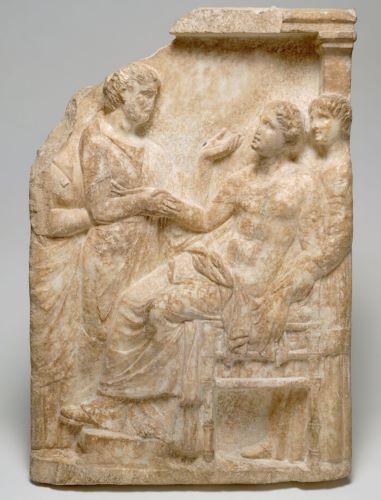

To create life was to both bless and burden the body that carried it.

By Matthew A. McIntosh
Public Historian
Brewminate
Introduction
In the social fabric of ancient Greece, few biological experiences carried as much philosophical, medical, and civic weight as pregnancy. Far from being a mere biological event, pregnancy in Greek antiquity was interwoven with ideas of the body, gender, the state, and divine order. The cultural perceptions of pregnancy not only defined a woman’s role but also contributed to broader ideologies about citizenship, the cosmos, and the fragility of mortal existence. Through an examination of medical texts, religious practices, and philosophical commentary, we uncover a society both fascinated and anxious about the gestating female body — one that was both essential to the continuation of the polis and simultaneously perceived as dangerous, unstable, and profoundly “other.”
The Hippocratic Womb: Medical Perspectives on Gestation
The earliest systematic understanding of pregnancy in ancient Greece is preserved in the Hippocratic Corpus, a collection of texts from the 5th and 4th centuries BCE. These works offer a window into how the body of a pregnant woman was conceived not merely as an anatomical structure but as a site of mysterious forces.
The Hippocratic writers viewed the female body as porous, moist, and inherently leaky — prone to imbalances of humors that needed regular correction. Pregnancy was thought to temporarily stabilize a woman’s naturally unstable constitution. As one treatise explains, “It is better for a woman to be pregnant, for then the flow of blood is diverted to the fetus, and she is less likely to fall into illness.”1 This perception inverted the modern logic of gestation as a burden; in the Hippocratic view, pregnancy offered a temporary reprieve from a woman’s otherwise pathological state.
However, the risks of miscarriage, stillbirth, or what they termed “false pregnancies” were ominously frequent. Remedies often involved fumigation, pessaries, and controlled sexual intercourse to either encourage or discourage conception.2 These medical interventions reflected a broader anxiety about the body’s lack of self-regulation — particularly the female body, which was believed to be more prone to deviation and mystery than the male.
Religious and Ritual Dimensions

Pregnancy was not merely biological; it was also spiritual and religiously coded. Childbearing women in ancient Greece regularly invoked goddesses such as Artemis, Hera, and Eileithyia — the last being the goddess specifically charged with aiding childbirth.3
Sacrifices and votive offerings to these deities reveal the precarity of pregnancy in a world without reliable obstetrics. At the sanctuary of Eileithyia in Amnisos, Crete, for example, numerous terracotta figurines and inscriptions implore the goddess for a safe delivery.4 Women would often wear amulets or inscribe protective prayers, reflecting their belief that spiritual forces could influence the outcome of gestation.
These rituals underscore the ancient Greek perception that pregnancy placed a woman in a liminal state — partway between health and sickness, life and death, purity and pollution. The childbearing body was sacred, but also potentially threatening, requiring management by both doctors and deities.
Civic Motherhood: Pregnancy and the State

In classical Athens, pregnancy took on an explicitly political character. With the Periclean citizenship law of 451 BCE, legitimate citizenship was granted only to children born of two Athenian parents.5 This legal change placed enormous emphasis on the reproductive capacity and fidelity of Athenian women. Their wombs were not merely vessels of life, but of the polity itself.
The Athenian oikos (household) was the nucleus of civic life, and its continuity depended on female reproduction. A woman who miscarried frequently or failed to produce male heirs could face severe familial and social pressure.6 Moreover, the secrecy of female biology lent itself to suspicion and surveillance — with questions of paternity and inheritance casting a shadow over even successful births.
In contrast, Sparta cultivated a very different ethos around pregnancy. Spartan women were famously encouraged to bear strong sons for war. Their physical training and public visibility (rare in most Greek poleis) were directly tied to the expectation of robust childbirth.7 In both cases, however, pregnancy was never a private affair. It was tied to the health and continuity of the state.
Philosophical Reflections: The Womb and the Cosmos
Greek philosophers, especially Plato and Aristotle, also weighed in on pregnancy, seeing it as a metaphor for broader truths about matter, form, and generation. In the Timaeus, Plato compares the uterus to a living creature with its own desires — a kind of beast within.8 This almost mythological framing of the womb illustrates the male philosophical imagination grappling with something both vital and alien.
Aristotle, though more systematic, still positioned the female role as fundamentally passive. In his biological writings, he asserted that the male provides the “form” (soul) and the female the “matter” (body) in reproduction.9 This gendered model of generation underpinned a cosmic hierarchy in which active male principles shaped the inert, disorderly female substrate — a philosophical rationale for deeply entrenched gender inequality.
Pregnancy, then, was not only about offspring, but about how the Greeks understood creation itself. The gestating woman was both revered and reduced, celebrated as a source of life and constrained as a potential threat to rational, masculine order.
Conclusion: The Tension of Creation
To be pregnant in ancient Greece was to inhabit a state of paradox. The expectant mother was at once a vessel of divine promise and a body in need of control. Medicine sought to regulate her, religion to protect her, the state to utilize her, and philosophy to define her. Pregnancy was a crucible in which ancient Greek ideas about gender, body, nature, and power were all tested.
In recovering these perspectives, we gain not only insight into ancient medicine and gender roles, but also a deeper understanding of how human societies shape — and are shaped by — the mystery of reproduction. In the Greek imagination, to create life was to both bless and burden the body that carried it.
Appendix
Endnotes
- Hippocrates, Diseases of Women, in Hippocratic Writings, ed. G.E.R. Lloyd, trans. J. Chadwick (London: Penguin Classics, 1978), 320.
- Ibid., 325–27.
- Jennifer Larson, Greek Nymphs: Myth, Cult, Lore (Oxford: Oxford University Press, 2001), 203.
- Angeliki Pieri, “Childbirth in Ancient Greece: The Role of Eileithyia,” Kernos 29 (2016): 85–104.
- Aristotle, Athenian Constitution, 26.4.
- Sarah B. Pomeroy, Goddesses, Whores, Wives, and Slaves: Women in Classical Antiquity (New York: Schocken Books, 1995), 64–65.
- Paul Cartledge, Spartan Reflections (Berkeley: University of California Press, 2001), 87.
- Plato, Timaeus, 91c–d.
- Aristotle, Generation of Animals, II.1, 731b.
Bibliography
- Aristotle. Athenian Constitution. Translated by P.J. Rhodes. London: Penguin Books, 1984.
- Aristotle. Generation of Animals. Translated by A.L. Peck. Loeb Classical Library. Cambridge, MA: Harvard University Press, 1942.
- Cartledge, Paul. Spartan Reflections. Berkeley: University of California Press, 2001.
- Hippocrates. Hippocratic Writings. Edited by G.E.R. Lloyd. Translated by J. Chadwick et al. London: Penguin Classics, 1978.
- Larson, Jennifer. Greek Nymphs: Myth, Cult, Lore. Oxford: Oxford University Press, 2001.
- Pieri, Angeliki. “Childbirth in Ancient Greece: The Role of Eileithyia.” Kernos 29 (2016): 85–104.
- Plato. Timaeus. Translated by Donald J. Zeyl. Indianapolis: Hackett Publishing, 2000.
- Pomeroy, Sarah B. Goddesses, Whores, Wives, and Slaves: Women in Classical Antiquity. New York: Schocken Books, 1995.
Originally published by Brewminate, 07.09.2025, under the terms of a Creative Commons Attribution-NonCommercial-NoDerivatives 4.0 International license.


